#forgery
Photo

Forgery of stag-shaped vessel / Place of Origin: Iran / Date: approx. 1900-1965 / Materials: Burnished earthenware / Style or Ware: Marlik style
7K notes
·
View notes
Text
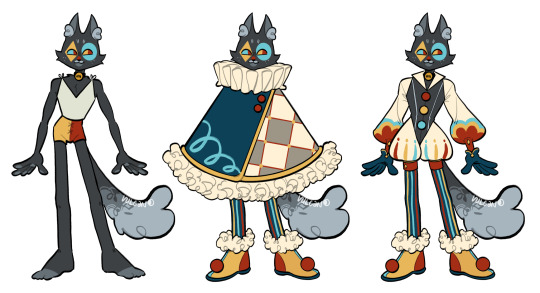


designs for my next character in a pathfinder game w pals (: their name is forgery and they're a catfolk changeling bard
#my art#digital art#portfolio#ocs#oc#original art#original character#furry#extra info: they are mute and the voicebox lets them talk like a vocaloid#forgery
2K notes
·
View notes
Text
i’m genuinely crying abt scourges page on the villains wiki
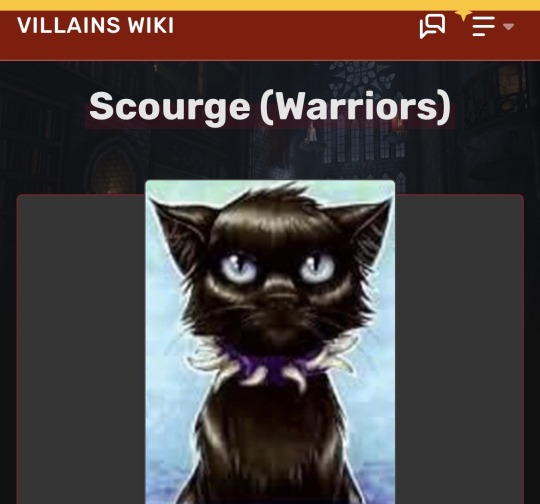


415 notes
·
View notes
Text

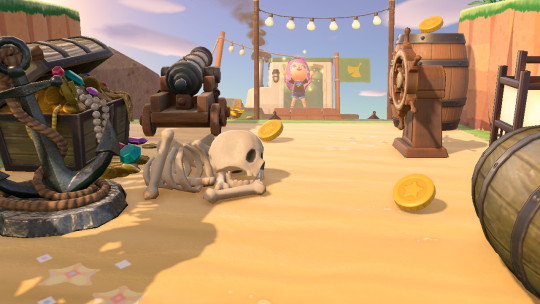
When you successfully buy a real painting from the crazy guy who sells forgeries 😂😂
#lmao#forgery#real#crazy redd#cousin#resident representative#acnh resident representative#acnh#acnh life#acnh island#acnh hype#acnh community#acnh blog#animal crossing#new horizons#animal crossing new horizons#animal crossing: new horizons#nintendo#nintendo switch#nintendo switch games#nintendo acnh#acnh nintendo#switch#switch games#switch acnh#acnh switch
41 notes
·
View notes
Text
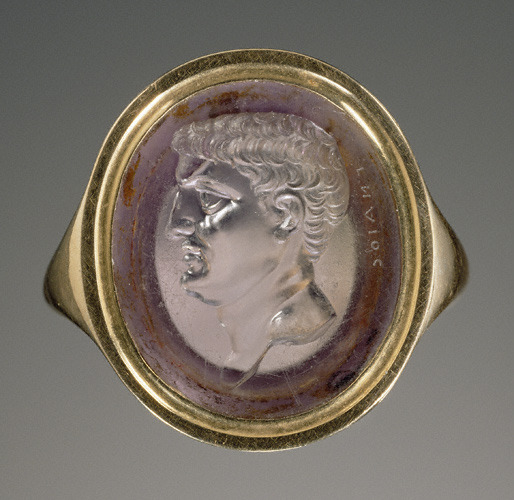
Intaglio set in a ring portraying Roman general and triumvir Mark Antony, presented as made by ancient carver Gnaios.
In 2021 it was proven that the gem is the 19th century forgery.
86 notes
·
View notes
Text
->The Lost Painting

La Mesa Herida - (The Wounded Table), 1940 by Frida Kahlo
The Lost Painting
Frida Kahlo's "La Mesa Herida" (The Wounded Table) is considered to be her masterpiece. For a long time it hung in her dining room, before she donated it to the Soviet Union. The Soviet Union rejected it considering it "bourgeois, formalist and decadent."

Photo: First exhibition organized by the Seminary of Mexican Culture and installed in the Palacio de Bellas Artes, inaugurated on 20 November 1942.
The Last Supper-like work was sent to Warsaw for an exhibition that would travel around several socialist countries, but the painting never made it past the first stop. "The Wounded Table" considered to be the one of the greatest exponents of surrealism, just vanished.
"The Wounded Table" became a holy grail for Kahlo scholars. It's reported that Kahlo herself lived with bitterness the loss and that Mexico tried by all means to locate the painting with the intention of returning it to the national heritage, but nothing was known about it - until now.
A Galician (NW Spain) art dealer has put it up for sale according to the interest of its owner, a Mexican settled in Europe.
Cristian López Márquez is that person who claims to have ended 65 years of mystery. With two other Mexican partners, he is the owner of the company The Billion Art, dedicated to the sale and purchase of works of art. He explains that, for the six and a half decades without knowing anything of what is considered the masterpiece of surrealism, it passed through two important private collections before reaching the hands of the current property.

The painting alleged to be "The Wounded Table" is in London, in a high-security vault that belongs to a private collection. The photo corresponds to the current status of the painting
Analyzed by experts
The dealer has no doubt that this is the coveted work of Frida Kahlo. Experts hired by his company were in charge of verifying this by contrasting the painting with that of other works by the Mexican artist. He calculates that the value of The "Wounded Table" is between 40 and 50 million euros: "The owner is looking for a buyer within European art circles, in which great collectors of works are made with paintings of this style", Cristian López says.
However, Kahlo scholars argue that López’s claim is dubious at best. Art historian Helga Prignitz-Poda, who has investigated the missing artwork in-depth, says images of López’s find reveal clear differences between the work in question and photographs of the original 1940 painting. Additionally, The Wounded Table was painted on wood, while this painting is listed as a work on canvas.
The newly resurfaced painting bears similarities to inaccurate replicas of the original, potentially suggesting that it’s a copy of a copy, according to Prignitz-Poda.

Visitors at the ZAMEK Culture Centre in Poznan, Poland, look at a black-and-white photo reproduction of Kahlo's lost work, The Wounded Table. Janek Skarzynski / AFP via Getty Images
So the search continues for the Kahlo Masterpiece.
At 2.4 metres long by 1.2 metres high (eight by four feet), larger than a standard door, the painting was unusual for Kahlo, who preferred to work small, unlike her muralist ex-husband Rivera.
This self-portrait was painted during the end of 1939 to the beginning of 1940. In December of 1939, Frida Kahlo and Diego Rivera's divorce became final. Frida started working on this painting as an expression of her despair and loneliness. This is her only other large painting, not only by size, but also by the complexity.

In the painting Frida is surrounded by objects which represent one aspect of her emotional situation. The table has human legs and its surface is bleeding on the few knots. This table is a symbol of Frida's sense of broken family from the divorce. There are several objects around the table. In the center was Frida herself, surrounded by all the objects who accompany her. She looks directly at the viewer, wearing her Tehuana clothes and jewelry, with blood dripping on her skirt, the same skirt she's wearing in "The Two Fridas."
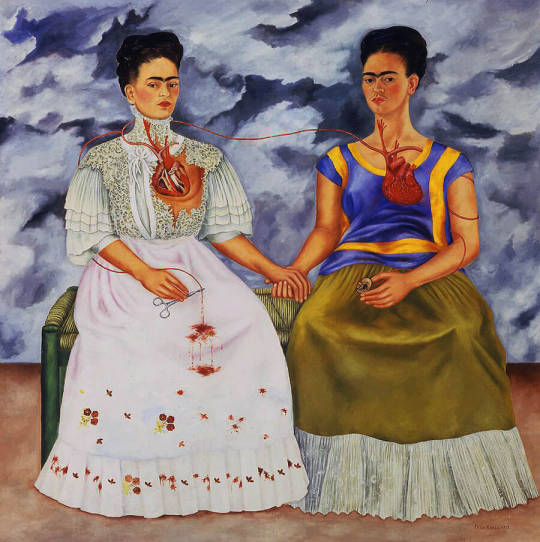
The Two Fridas, 1939 by Frida Kahlo
Her hair are open on one side. A deep wound, no longer bleeding, can be seen on her neck. On one side is her sister Cristina's two children, which is a reflection of her desire to have her own children. On the other side is a deer, one of her favorite pet and she use that as her surrogate children. Sitting right next to her is a Nayarit figure. Frida gives to the Nayarit figure on her left side, a cup containing her last drops of blood so the Nayarit can drink it. The tall Judas figure is considered as Diego Rivera, who plays the role of the betrayal. The characters are arranged in the scene that recalls The Last Supper by Leonardo da Vinci.
Perhaps one day it will be found. Many Kahlo scholars believe it was destroyed, likely burned during the war and lost forever.
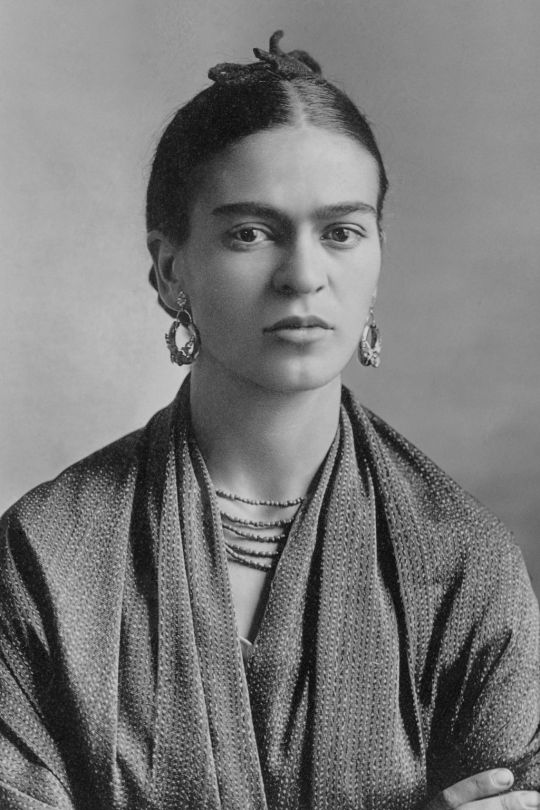
Frida Kahlo, photographed by her father Guillermo Kahlo in 1932
🔽 Bonus Portrait 🔽

''Dualidad vibratoria'' - ''Vibratory duality'' - Portrait of Frida with parrot. by Yuma Díaz
#art#paintings#La Mesa Herida#The Wounded Table#Cristian López Márquez#Helga Prignitz-Poda#frida kahlo#Guillermo Kahlo#leonardo da vinci#the two fridas#Yuma Díaz#cristina kahlo#diego rivera#kahlo#nayarit#fake#forgery#janek skarzynski
84 notes
·
View notes
Text
In a classic case of modern technology getting to the truth, a ‘rare specimen’ fossil deemed scientifically important, but which baffled science, has been revealed as a forgery, with the supposed fossilized skin revealed as black paint.
21 notes
·
View notes
Link
[...] Once the doors were closed, Caroline Rudd made a startling confession: it was she who had forged the bond and instructed her clueless brother-in-law to cash a loan on it. Her remorse was both deep and eloquent—it was only a silly game played by a bored housewife, she lamented. Robert was a good man with children to support, and she would be utterly heartbroken if he were arrested for her foolishness.
Despite Caroline’s flowing tears and prostrate pleading, the Drummonds were skeptical. How could a delicate woman possibly imitate a man’s handwriting? It must be that sweet Caroline was altruistically covering for her brother-in-law’s misdeeds, the Drummonds decided, perhaps even in fear of him. For that matter, where was her husband in all of this? How could they even be sure that it was Robert who had come to them yesterday, or who had returned the second time with tales of elderly socialites on horseback?
So Caroline offered the bankers a demonstration—as long as they agreed to destroy it afterward, so the evidence could not be used against her. According to the Drummonds, Caroline reproduced the fake signature on the bond perfectly, then burned the paper in the fireplace.[...]
115 notes
·
View notes
Photo
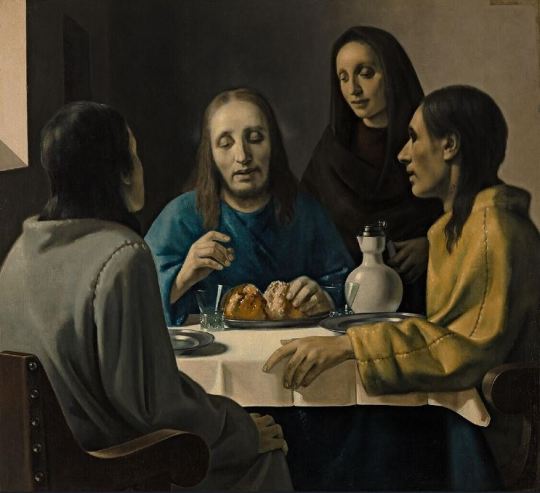
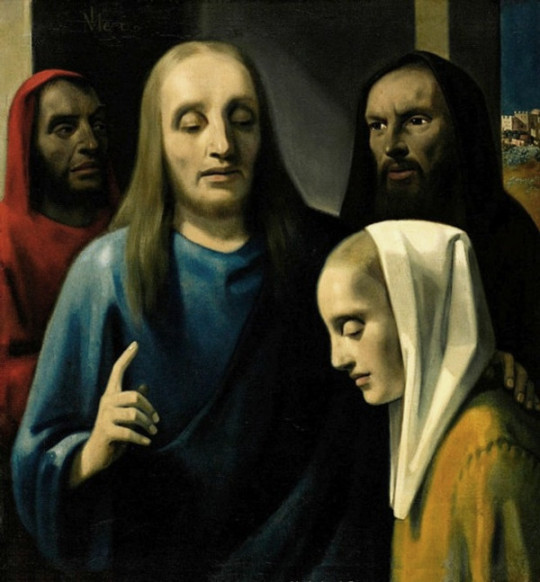
Hans Van Meegeren
Vermeer forgeries
In May 1945, Van Meegeren was arrested, charged with collaborating with the enemy and imprisoned. His name had been traced to the sale made during WW II of what was then believed to be an authentic painting Vermeer to Nazi Field-Marshal Hermann Goering. Shortly after, to general disbelief, Van Meegeren came up with a very original defense against the accusation of collaboration, then punishable by death. He claimed that the painting, The Woman Taken in Adultery, was not a Vermeer but rather a forgery by his own hand. Moreover, since he had traded the false Vermeer for 200 original Dutch paintings seized by Goering at the beginning of the war, Van Meegeren believed he was a national hero rather than a Nazi collaborator. He also claimed to have painted five other "Vermeers" as well as two "Pieter de Hoochs" all of which had surfaced on the art market since 1937.

Van Meegeren painting Jesus Among the Doctors in 1945
Personally, I never understood why the art world was fooled by these. Van Meegeren is such a primitive painter when compared with Vermeer
130 notes
·
View notes
Text
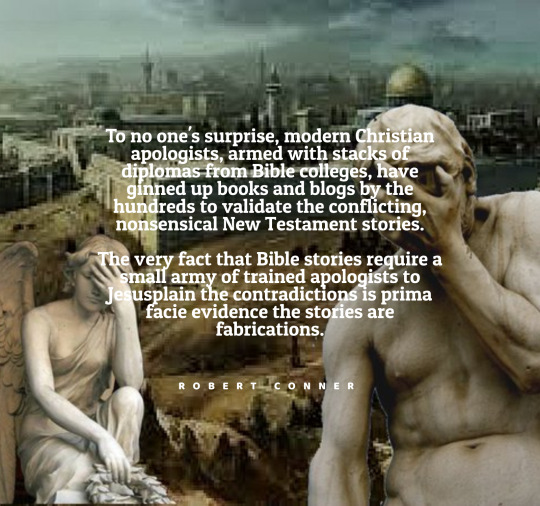
"To no one's surprise, modern Christian apologists, armed with stacks of diplomas from Bible colleges, have ginned up books and blogs by the hundreds to validate the conflicting, nonsensical New Testament stories.
The very fact that Bible stories require a small army of trained apologists to Jesusplain the contradictions is prima facie evidence the stories are fabrications."
-- Robert Conner
#Robert Conner#christianity#bible#bible study#christian apologetics#religious apologetics#new testament#bible forgeries#forgery#pseudepigrapha#religion#religion is a mental illness
86 notes
·
View notes
Text
There's a secret art to forgery, and Moist had discovered it: in a hurry, or when excited, people will complete the forgery by their own cupidity. They'll be so keen to snatch the money from the obvious idiot that their own eyes filled in all the little details that weren't there on the coins they so quickly pocketed. All you needed to do was hint at them.
Terry Pratchett, Going Postal
#moist von lipwig#going postal#discworld#terry pratchett#persuasion#conman#criminal#forgery#self deception#psychology#human nature#in a hurry#taking advantage#the secret art to forgery#all you need to do
170 notes
·
View notes
Text

Redd Animal Crossing in a nutshell
#nintendo#animal crossing#acnh#animal crossing new horizons#red fox#ac redd#my doodles#forgery#fake art#trickster#in a nutshell#mischievous#nintendo fanart
6 notes
·
View notes
Text
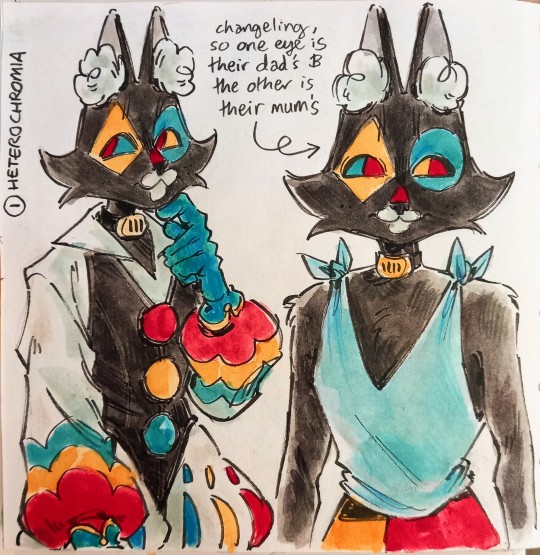
cringetober day 1: heterochromia. decided to go with my pathfinder oc forgery for this one (:
#cringetober#my art#original art#oc#original character#ttrpg oc#pathfinder#furry#catfolk#clowncore#cringetober 2023#heterochromia#watercolor#watercolour#sketchbook#forgery
492 notes
·
View notes
Text
Episode 2: Lisa Fagin Davis on a Fragment, a Forgery, and a Fiend

Women bathing in the Voynich manuscript
In Episode 2 of Inside My Favorite Manuscript, Dot and Lindsey talk to manuscript scholar Lisa Fagin Davis about three of her favorite manuscripts, all of which happen to be in the collections of the Beinecke Library at Yale University:
The Gottschalk Antiphonary, now a collection of fragments
Epistolary, Cistercian Use, a 15th century manuscript with substantial forged illustrations added in the 19th century
Cypher Manuscript aka The Voynich Manuscript, a fiend of a manuscript that has proven itself impossible to decipher
Listen to the episode here or wherever you get your podcasts!
Join our mailing list to receive weekly updates about the IMFM pod!
Below the cut are photos of some of the specific things we discuss in this episode.
Beinecke MS 481.51: Gottschalk Antiphonary:

Beinecke MS 283: Epistolary, Cistercian Use:


Beinecke MS 408: Cypher Manuscript aka The Voynich Manuscript
Page from the herbal section:
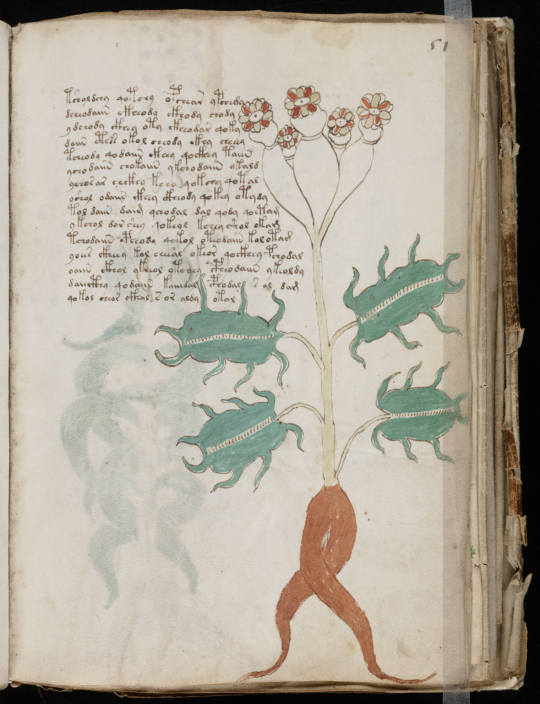
Page opening from the astrological / zodiacal section:

Page from the bathing section:

Large fold-out:
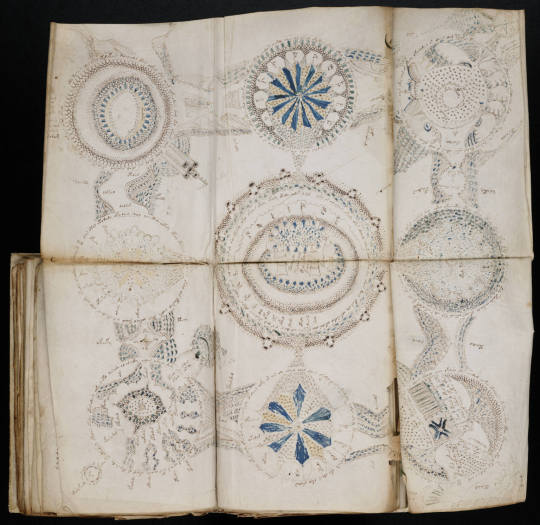
Voynich Conference. Virtual conference! November 30-December 1, register now!
The Medievalist: A Novel, by Phil Adamo.
#medieval#manuscript#antiphonary#forgery#spanish forger#voynich#voynich manuscript#podcast#imfm#inside my favorite manuscript
88 notes
·
View notes
Link
The Dead Sea Scrolls, first uncovered by a trio of Bedouin wandering the Judean Desert in 1947, provide a fascinating glimpse into what Scripture looked like during a transformative period of religious ferment in ancient Israel. The scrolls include the oldest copies ever found of the Hebrew Bible, “apocryphal” texts that were never canonized, and rules and guidelines for daily living written by the community of people who lived at Qumran, where the first scrolls were found. All told, scholars have identified as many as 100,000 Dead Sea Scrolls fragments, which come from more than 1,000 original manuscripts.
Experts date the scrolls between the third century B.C. and the first century A.D. (though Langlois believes several may be two centuries older). Some of them are relatively large: One copy of the Book of Isaiah, for example, is 24 feet long and contains a near-complete version of this prophetic text. Most, however, are much smaller—inscribed with a few lines, a few words, a few letters. Taken together, this amounts to hundreds of jigsaw puzzles whose thousands of pieces have been scattered over many different locations around the world.
In 2012, Langlois joined a group of scholars working to decipher close to 40 Dead Sea Scrolls fragments in the private collection of Martin Schøyen, a wealthy Norwegian businessman. Each day in Kristiansand, Norway, he and specialists from Israel, Norway and the Netherlands spent hours trying to determine which known manuscripts the fragments had come from. “It was like a game for me,” Langlois said. The scholars would project an image of a Schøyen fragment on the wall beside a photograph of a known scroll and compare them. “I’d say, ‘No, it’s a different scribe. Look at that lamed,’” Langlois recalled, using the word for the Hebrew letter L. Then they would skip forward to another known manuscript. “No,” Langlois would say. “It’s a different hand.”
Each morning, while out walking, the scholars discussed their work. And each day, according to Esti Eshel, an Israeli epigrapher also on the team, “They were killing another identification.” Returning to France, Langlois examined the fragments with computer-imaging techniques he had developed to isolate and reproduce each letter written on the fragments before beginning a detailed graphical analysis of the writing. And what he discovered was a series of flagrant oddities: A single sentence might contain styles of script from different centuries, or words and letters were squeezed and distorted to fit into the available space, suggesting the parchment was already fragmented when the scribe wrote on it. Langlois concluded that at least some of Schøyen’s fragments were modern forgeries. Reluctant to break the bad news, he waited a year before telling his colleagues. “We became convinced that Michael Langlois was right,” said Torleif Elgvin, the Norwegian scholar leading the effort.
After further study, the team ultimately determined that about half of Schøyen’s fragments were likely forgeries. In 2017, Langlois and the other Schøyen scholars published their initial findings in a journal called Dead Sea Discoveries. A few days later, they presented their conclusions at a meeting in Berlin of the Society of Biblical Literature. Flashing images of the Schøyen fragments on a screen, Langlois described the process by which he concluded the pieces were fakes. He quoted from his contemporaneous notes on the scribe’s “hesitant hand.” He pointed out inconsistencies in the fragments’ script.
And then he dropped the gauntlet: The Schøyen fragments were only the beginning. The previous year, he said, he’d seen photos of several Dead Sea Scrolls fragments in a book published by the Museum of the Bible, in Washington, D.C., a privately funded complex a few blocks from the U.S. Capitol. The museum was scheduled to open its doors in three months, and a centerpiece of its collection was a set of 16 Dead Sea Scrolls fragments whose writing, Langlois now said, looked unmistakably like the writing on the Schøyen fragments. “All of the fragments published there exhibited the same scribal features,” he told the scholars in attendance. “I’m sorry to say that all of the fragments published in this volume are forgeries. This is my opinion.”
The weight of the evidence presented that day by several members of the Schøyen team led to a re-evaluation of Dead Sea Scrolls in private collections all over the world. In 2018, Azusa Pacific University, a Christian college in Southern California that had purchased five scrolls in 2009, conceded that they were likely fakes, and it sued the dealer who had sold them. In 2020, the Southwestern Baptist Theological Seminary, in Fort Worth, Texas, announced that the six Dead Sea Scrolls it had purchased around the same time were also “likely fraudulent.”
The most stunning admission came from executives at the Museum of the Bible: They had hired an art-fraud investigator to examine the museum’s fragments using advanced imaging techniques and chemical and molecular analysis. In 2020, the museum announced that its prized collection of Dead Sea Scrolls was made up entirely of forgeries.
Langlois told me that he derives no pleasure from such discoveries. “My intention wasn’t to be an expert in forgeries, and I don’t love catching bad guys or something,” he told me. “But with forgeries, if you don’t pay attention, and you think they are authentic, then they become part of the data set you use to reconstruct the history of the Bible. The entire theory is then based on data that is false.” That’s why ferreting out biblical fakes is “paramount,” Langlois said. “Otherwise, everything we are going to do on the history of the Bible is corrupt.”
#history#languages#linguistics#religion#christianity#judaism#forgery#biblical hebrew#bible#dead sea scrolls#michael langlois
70 notes
·
View notes
Text
Even though it’s a fake, just holding this paperwork makes me feel like less of a forgery myself. Growing up, there were no photographs of Ma and me around the apartment, no documents of any kind proving I exist. And while the details in this Huella may be falsified, at least it’s my face inside.
Evidence I’m real.
I exist.
—Romina Garber/Cazadora
3 notes
·
View notes